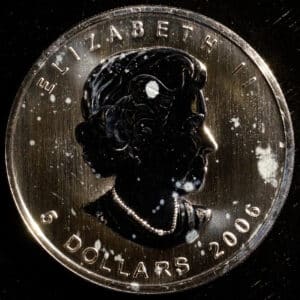Title: Understanding Milk Spots on Silver Coins: 5 Causes, Prevention, and Value Implications
Introduction
Investing in precious metals, particularly silver coins and bars, is a popular way to preserve wealth and diversify one’s portfolio. However, avid collectors and investors might be familiar with an unfortunate issue that can affect the pristine appearance and value of their silver holdings: milk spots. In this comprehensive guide, we will explore the various aspects of milk spots on silver coins, including what causes them, how to prevent them, their impact on coin values, when they tend to occur, and the best types of coins to buy to avoid this nuisance. Check out Milk Spot Explanations on YouTube to learn what other investors and collectors do to prevent these white spots.
What Are Milk Spots?

Silver Eagle with Milk Spots
Milk spots, also known as white spots or white haze, are small, cloudy blemishes that appear on the surface of silver coins and bars, giving them an unsightly, milky appearance. These imperfections can occur on a variety of silver products, including coins, rounds, bars, and bullion. They are particularly common on modern silver coins, often overshadowing the coin’s overall design and luster. These spots can be disappointing for collectors and may potentially impact the coin’s market value.
Types of Coins and Bars That Get Milk Spots
While milk spots can affect various types of silver coins and bars, they tend to be more prevalent on certain products, including:
Bullion Coins: These are typically coins minted for investment purposes, such as American Silver Eagles, Canadian Silver Maple Leafs, and Austrian Silver Philharmonics. Bullion coins are more prone to milk spots due to the large production quantities.
Mint Sets: Coins found in mint sets, particularly Proof or Brilliant Uncirculated sets, may also develop milk spots.
Silver Rounds: Rounds produced by private mints can sometimes exhibit milk spots, though their occurrence is generally lower compared to bullion coins.
Older Coins: While less common, milk spots can occasionally appear on vintage silver coins, but this is relatively rare.

2006 Maple Leaf with Milk Spots
Causes of Milk Spots
The exact cause of milk spots is a topic of debate among collectors and experts, but several contributing factors have been identified:
Chemical Reactions: Silver coins contain a combination of metals, including copper. It is believed that chemical reactions between the silver and copper content, as well as other environmental factors, may lead to the development of milk spots.
Minting Process: The minting process itself can introduce impurities or contaminants that result in milk spots. It is suggested that certain cleaning agents or machinery used in mints may play a role.
Environmental Factors: Environmental conditions, such as temperature and humidity, may contribute to the formation of milk spots during storage.
Coin Capsules: Some collectors have reported the occurrence of milk spots even when coins were stored in protective capsules, leading to speculation that the capsules themselves may be a source of contamination.
Is It Possible to Remove Milk Spots from Silver?
Removing milk spots from silver coins is a delicate and often unsuccessful endeavor. Attempting to clean or remove the spots can lead to further damage and may significantly reduce the coin’s value. For this reason, it is generally advised against trying to remove milk spots. Prevention is the best approach.
Does It Affect the Value?
Milk spots can indeed affect the value of silver coins, particularly for collectors who prioritize aesthetics and overall condition. Coins with milk spots are typically considered less desirable and may sell for a lower premium compared to spotless specimens of the same type. However, the impact on value can vary, with some buyers more tolerant of milk spots than others. Investors, who primarily focus on the silver content, may be less concerned about milk spots affecting the coin’s value.
When Do Milk Spots Occur?
Milk spots can appear at various stages of a coin’s life, including shortly after minting, during storage, or even after years in a collector’s possession. The exact timing of milk spot formation is unpredictable, making it a source of frustration for collectors and investors alike. It is not exclusive to older or newer coins, and even coins kept in protective cases may develop milk spots.
Preventing Milk Spots
While preventing milk spots entirely is challenging, there are steps collectors can take to reduce the risk:
Proper Storage: Store your silver coins in a cool, dry, and stable environment. Avoid extreme temperature fluctuations and humidity, as these conditions can exacerbate milk spot development.
Avoid Touching: Handle your silver coins as little as possible and use gloves to minimize the transfer of oils and contaminants from your hands.
Choose Carefully: Research and select coins from mints with a reputation for producing milk-spot-resistant products. Some mints have taken measures to minimize milk spot occurrences.
Individual Packaging: When storing or displaying your coins, use individual coin capsules or holders to prevent contact with other coins.
Best Types of Coins to Buy to Avoid Milk Spots

Silver Kangaroo with Milk Spots
If you are concerned about milk spots and want to minimize the risk, consider investing in coins from mints that are known for producing milk-spot-resistant products. While no coin is entirely immune to milk spots, certain mints have taken proactive measures to address the issue. Coins from the Royal Canadian Mint (RCM) have garnered a reputation for having fewer milk spots, thanks to changes in their minting process.
Additionally, older coins or vintage silver coins may be less susceptible to milk spots, though this is not a guarantee. It is important to do thorough research and buy from reputable sources when adding coins to your collection.
Conclusion
Milk spots on silver coins, silver rounds, and silver bars can be a source of frustration for collectors and investors, as they may affect the coin’s aesthetics and, subsequently, its value. While prevention is challenging, proper storage, careful selection of coins, and research into minting practices can help reduce the risk of milk spot occurrence. By understanding the causes and taking preventive measures, collectors can enjoy their silver coins without the unwelcome appearance of milk spots.
It is important to buy from reputable sources such as FMR Gold who stand by their products and guarantee customer satisfaction. Depending on the age of the coin and the coin type (whether it be a proof coin, sovereign bullion coin, or a silver round) this can be a tough problem to overcome. Most trusted coin dealers will stand by their products and swap out the affected coins. Other dealers are likely to claim “all sales are final”, so be sure to keep that in mind when choosing a precious metals dealer.







